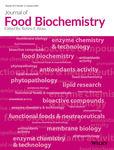Effect of the polyphenol-rich extract from Allium cepa on hyperlipidemic sprague-dawley rats
Abstract
Allium cepa is used for the prevention and treatment of hyperlipidemia-related diseases such as atherosclerosis in the folk. This study was mainly aimed at investigating the effects of A. cepa extract (ACE) enriched in polyphenols on hyperlipidemia Sprague-Dawley (SD) experiment rat models. The levels of total cholesterol (TC), triglyceride (TG), low-density lipoprotein cholesterol (LDL-C), high-density lipoprotein cholesterol (HDL-C), malondialdehyde (MDA), and superoxide dismutase (SOD) activity in serum and liver were measured using ELISA kits. In addition, hematoxylin-eosin (HE) technique was used to observe the liver and the aortic arch pathology. Moreover, western blotting (WB) method was applied to analyze LDL receptor (LDLR) and 3-hydroxy-3-methylglutaryl (HMG)-CoA reductase (HMGCR) in liver. As a result, quercetin (2.42 mg/g DW) and isoquercitrin (4.60 mg/g DW) were the main constituents of ACE using HPLC analysis. Furthermore, ACE reduced the levels of TC, TG, LDL-C, and MDA, and increased HDL levels and elevated SOD activity both in serum and liver in hyperlipidemic SD rats (p < .05). HE results showed that liver fat drops of the rats in ACE group were obviously decreased, and the lipid and foam cells of the aortic arch of the rats in ACE group were markedly ameliorated. WB results showed that ACE promoted the degradation of HMGCR and increased LDLR expression in liver (p < .05). In conclusion, ACE alleviated hyperlipidemia with downregulation of HMGCR and upregulation of LDLR.
Practical applications
Atherosclerosis, a major cardiovascular disease, is the leading cause of mortality and morbidity in the developed countries. Moreover, accumulating data indicate that, during atherosclerosis development, hyperlipidemia is an important risk factor. To date, hyperlipidemia is mainly treated with hyperlipidemic agents including statins, in spite of the side effects and poor tolerance in some patients. In addition, Allium cepa is a medicinal and edible plant. Furthermore, A. cepa is used for the prevention and treatment of hyperlipidemia-related diseases such as atherosclerosis in the folk. But the underlying mechanism is still unclear. In fact, this research showed that A. cepa extract (ACE) alleviated hyperlipidemia with downregulation of HMGCR and upregulation of LDLR, suggesting that ACE might be a potential option for hyperlipidemia as non-statin lipid-lowering agent.
CONFLICT OF INTEREST
The authors have no conflicts of interest to declare.




